The forestry philosophy of "persistence," which was born in 18th-century Germany during the time of deforestation, faced challenges.
Updated by Kotaro Nagasawa on August 19, 2025, 6:10 PM JST
Kotaro NAGASAWA
(Platinum Initiative Network, Inc.
Born in Tokyo in 1958. (Engaged in research on infrastructure and social security at Mitsubishi Research Institute, Inc. During his first few years with the company, he was involved in projects related to flood control, and was trained by many experts on river systems at the time to think about the national land on a 100- to 1,000-year scale. He is currently an advisor to Mitsubishi Research Institute, Inc. He is also an auditor of Jumonji Gakuen Educational Corporation and a part-time lecturer at Tokyo City University. Coauthor of "Introduction to Infrastructure," "New Strategies from the Common Domain," and "Forty Years After Retirement. D. in Engineering.
I am interested in the forestry industry in Germany. There are three reasons for this: first, Germany is the country that realized cultivated forestry along with Japan. One is that Germany is a country that has realized cultivated forestry alongside Japan, another is that it seems to have been led by experts, and a third is that Meiji Japan is said to have introduced German forestry. While searching through related books with this interest, I came across a very clear and interesting explanation. That book is "Forestry: German Forests and Japanese Forestry" by Yukikazu Murao. In this article, I would like to introduce the historical part of the book, organized in my own way. As a beginner in forestry, I referred to other books for understanding. References are listed at the end of the latter part of this article.
In the 17th century, the forests in Germany continued to decline significantly. At that time, Germany was under the so-called Westphalian system, or the Holy Roman Empire, which had been dismantled, and the princes held a great deal of sovereignty over the country. The domains continued to export timber as a source of funds to cover their national management costs, and to meet the rapid increase in domestic consumption (construction, etc.), they continued to extractively over-cut forests, which led to a critical situation known as "timber poverty" in the early 18th century.
While the administrators in charge of the management of the fiefdoms were considering measures, Hans Karl von Karlowitz (1650-1718), a mining official of the Duchy of Saxony (eastern Germany), first proposed the concept of "retention" in his book published in 1713. The two main points of the concept were "to keep the timber harvest below the growth rate of the forest volume" and "to plant trees with fast-growing timber species on the site of logging. The English translation of "Nachhaltigkeit" is "Sustainability.

In order to realize sustainable forestry, several issues needed to be overcome. These were (1) measurement of forest resources, (2) management methods for sustainable forestry, and (3) establishment of modern silvicultural techniques.
The Duchy of Saxony, one of the territories, invited the forestry scholar Heinrich Cotta (1763-1844) from Weimar and established the Royal Forestry Academy of Saxony in Taranto, near the capital Dresden, to promote theoretical and practical research and education on the above issues. The genealogy of forestry thought that emerged from this academy is called "Taranto forestry" by Murao. Cotta was a cultural figure who interacted with Goethe and Schiller during the Weimar period.
Max Pressler (1815-1886), a professor at the Royal Forestry Academy of Saxony, adopted the evolving ideas of capitalism and developed a theory of forest management based on the concept of "net return on land. He recommended short-term logging to maximize the continuous yield of forests, and advocated a shift from hardwoods such as beech, which takes time to grow, to softwoods such as spruce, which can be grown in a short period of time. This way of thinking about forest production from a financial perspective is called "forest accounting.
Johann Friedrich Judeich (1828-1894), who also served as the head of the Academy, is said to have summarized the Taranto forestry school. He described the ideal forest as "a large, uniform, simple forest divided by forest roads in a geometric pattern, like a grid. The tree species are, of course, conifers with short growing seasons.
At the base of Judaich's concept is the normahlwald (standard forest), which was translated as "Hosho-rin" in Meiji Japan. For example, if a tree is 60 years old and is to be harvested, there will be 60 plots, and if a predetermined number of plots are harvested and planted each year, the ideal rotation of trees will automatically be realized.
The goal of Tarrant Forestry is to create large-area, all-at-once, simple forests that are, so to speak, large-scale agroforestry operations. Some even consider it a type of plantation. Therefore, it has a number of limitations.
For example, it was recognized early on that simple forests (forests with only one species of tree) are vulnerable to weather damage such as disease, insects, wind and snow damage. In addition, because of mass afforestation, supply could not keep up with demand for seedlings, making it difficult to control quality; there was also the jump of unscrupulous companies, and furthermore, long-term changes in demand, such as increased demand for hardwoods, could not be met (this actually happened in Germany, apparently).
Tarrant forestry, as represented by the concept of Hosho-Forestry, is often model-driven, i.e., deductive. A school of thought has emerged since that time that forests should be viewed more inductively. This will be discussed in the next article. (Kotaro Nagasawa, Director, Platinum Network for Sustainable Development)
■Related Sites
Forestry: German Forests and Japanese Forestry" (Chikuchi-Shokan)